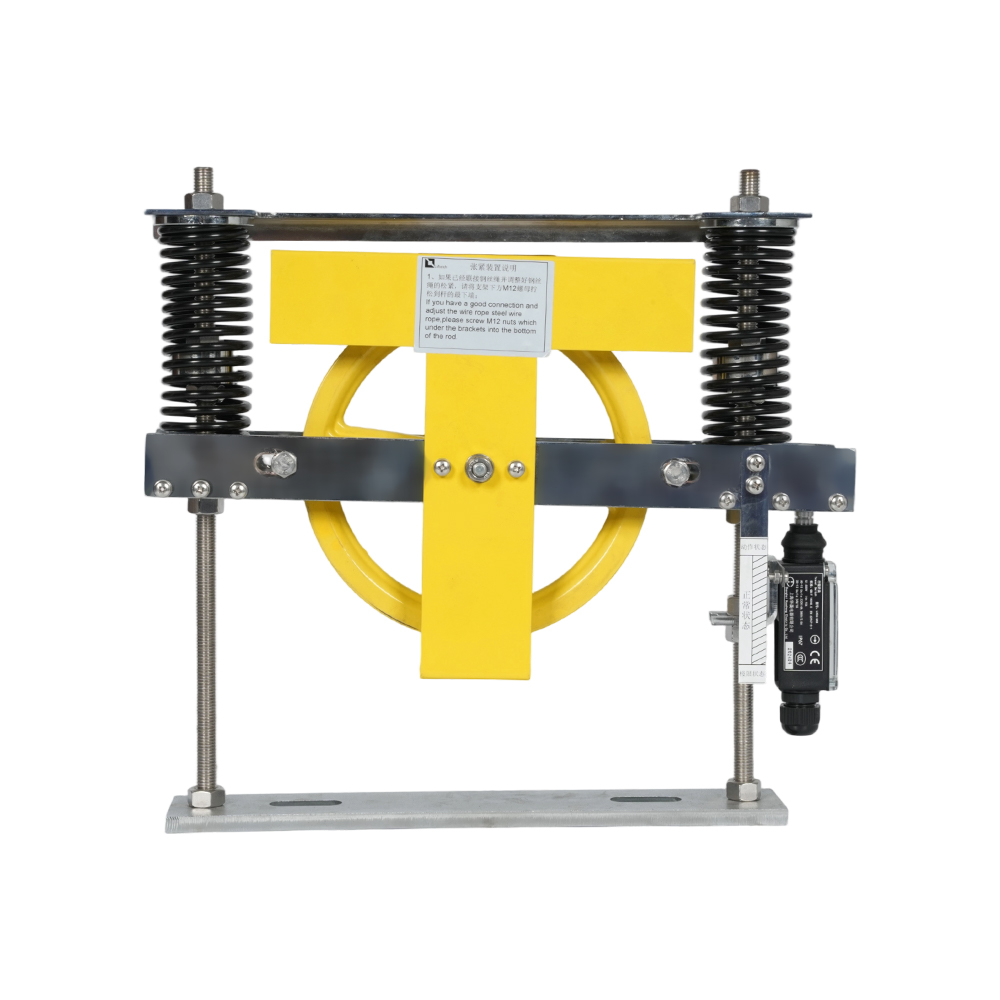How to Ensure Elevator Safety? The Importance and Maintenance of Elevator Wire Rope Brakes
Understanding Elevator Wire Rope Brakes
Elevators are indispensable vertical transportation tools in modern buildings, and their safety has always been a crucial consideration in design and operation. As urbanization accelerates and high-rise buildings increase, the frequency of elevator use continues to rise. Elevator wire rope brakes, as a key component of elevator safety systems, play a vital role in ensuring safety. In this article, we will delve into the working principles, functions, types, maintenance methods, and how they cooperate with other elevator safety components.
Overview of Elevator Braking Systems
The elevator braking system is designed to stop the elevator quickly and safely in case of an emergency. Brakes are one of the critical components of the elevator safety system, whose main function is to stop the elevator when it experiences overspeed, malfunction, or other faults. Elevator wire rope brakes play a crucial role in such scenarios. Their principle of operation is based on the friction between the elevator’s wire ropes and the braking device, which enables the elevator to stop safely.
Overview of Elevator Wire Rope Brakes
Elevator wire rope brakes, also known as rope braking devices, are mainly used to control the descent and stopping speed of the elevator. The brake works by creating friction between the elevator's steel cables and the braking device, allowing the elevator to stop safely. This mechanism ensures smooth operation and the safe halting of the elevator during emergencies, protecting passengers from accidents. With the continuous advancement of elevator technology, wire rope brakes are evolving, adopting more efficient and precise designs to meet the needs of various elevator systems.
The Role of Elevator Brakes in Safety
The safety of an elevator is determined not only by the elevator’s design and structure but also by its safety components. Elevator brakes, especially wire rope brakes, are essential to prevent accidents such as falling, overspeeding, or other dangerous situations.
How Elevator Wire Rope Brakes Ensure Safety
Elevator wire rope brakes are designed to stop the elevator quickly in case of emergencies such as overspeed, mechanical failure, or electrical failure. The brakes work by automatically engaging and applying friction to stop the elevator’s motion, ensuring passenger safety. In addition to stopping the elevator in emergencies, wire rope brakes also contribute to the smooth operation of the elevator by controlling the speed during regular movement, providing a more comfortable and stable ride for passengers.
The Key Role of Elevator Wire Rope Brakes in Preventing Freefall
One of the most significant safety risks in elevator operation is the potential for the elevator to fall. If the elevator experiences a mechanical failure or electrical issue, and the braking system fails to activate, the elevator could fall, resulting in severe injuries or fatalities. The elevator wire rope brake is designed to prevent such extreme situations. By continuously monitoring the elevator’s speed, the wire rope brake can detect abnormal movement and apply friction immediately to stop the elevator, preventing freefall and ensuring the safety of passengers.
Types of Elevator Braking Systems
Elevator braking systems are divided into several types based on their working principles and usage. In addition to wire rope brakes, elevators also use hydraulic and electromagnetic brakes. Each type of brake has its own advantages and is suitable for different elevator applications.
Hydraulic Elevator Brakes
Hydraulic elevator brakes are one of the most commonly used braking systems. Their principle of operation is based on the pressure of hydraulic fluid, which controls the elevator’s stopping speed. When the elevator is in motion, hydraulic oil is regulated through a valve to adjust the speed of the elevator. Hydraulic brakes provide precise control, ensuring smooth stops and reducing vibrations during operation.
Electromagnetic Elevator Brakes
Electromagnetic elevator brakes use an electromagnetic principle to apply brakes. An electric current creates a magnetic field that controls the braking mechanism. The primary advantages of electromagnetic brakes are their simplicity and quick response time. They are commonly used in high-end elevator systems, especially in super-high-rise buildings or specialized elevators.
Elevator Wire Rope Brakes
As previously mentioned, elevator wire rope brakes create friction between the steel rope and the braking device to stop the elevator. They are efficient, low-maintenance, and widely used in various elevator systems. Compared to hydraulic and electromagnetic brakes, wire rope brakes are more suitable for elevator systems that require frequent starts and stops, such as those in high-rise buildings and large commercial centers.
Advantages of Using Elevator Wire Rope Brakes
High Efficiency and Reliability
One of the main advantages of elevator wire rope brakes is their efficiency. In the event of a malfunction, the wire rope brake can be activated quickly and stop the elevator using friction. This makes the elevator safer and prevents accidents. Compared to other types of brakes, wire rope brakes have a quicker response time, making them more reliable in emergency situations.
Low Maintenance Requirements
Wire rope brakes are relatively simple in design, requiring minimal maintenance. In comparison to hydraulic and electromagnetic brakes, wire rope brakes have lower failure rates and do not require frequent replacement of parts. For buildings with high-frequency elevator use, wire rope brakes provide a cost-effective and reliable option.
Cost Effectiveness
Wire rope brakes are generally more cost-effective than hydraulic and electromagnetic brakes. They have lower manufacturing costs and require less frequent maintenance, making them a more economical option for elevator systems. For projects with limited budgets but requiring high-efficiency braking systems, wire rope brakes are an ideal choice.
Maintenance of Elevator Wire Rope Brakes: Best Practices
Proper maintenance of elevator wire rope brakes is essential to ensure their long-term reliable performance. Regular inspections and servicing are necessary to keep the brakes in optimal condition. Here are some best practices for maintaining elevator wire rope brakes:
Inspecting for Wear and Tear
Over time, elevator wire ropes can experience wear and tear. Checking for wear regularly helps to detect potential issues that could compromise braking performance. Look for signs such as cracks, corrosion, or visible damage on the steel ropes. Measure the rope diameter and angle to check for excessive wear and ensure that the wire rope is still in good condition.
Lubrication of Wire Ropes
Lubrication is an important step in extending the life of wire ropes. Proper lubrication reduces friction between the wire ropes and the braking system, preventing wear and maintaining flexibility. Regularly lubricating the wire ropes can also help to prevent rust and corrosion, ensuring that the ropes continue to function smoothly. Use suitable lubricants and apply them as recommended by the manufacturer.
Regular System Inspections
In addition to inspecting the wire ropes, it is essential to check the overall braking system. Check the brake pads and other components to ensure that they are in good working condition. Inspect the electrical control system to ensure it is functioning properly, and check the hydraulic oil levels if the elevator uses hydraulic brakes.
Creating a Maintenance Plan
To ensure long-term reliability, create a maintenance schedule that includes regular inspections and servicing. Perform monthly checks on the wire ropes and brake system, conduct a comprehensive inspection every three months, and schedule a full overhaul once a year to check all key components, especially the wire ropes and brakes.
Common Issues with Wire Rope Brakes
While elevator wire rope brakes are designed for durability and reliability, issues can occasionally arise. Below are some common problems and solutions:
1. Wire Rope Fractures or Severe Wear
Wire rope fractures or excessive wear can significantly impact the braking performance of the elevator. Regularly check the ropes for any signs of damage, and replace any worn-out or broken ropes immediately.
2. Slow Response of the Brake
If the brake is slow to respond, it may not stop the elevator quickly enough, leading to safety concerns. This could be due to worn brake pads, insufficient lubrication, or electrical control issues. Ensure that all components are in good condition and address any issues promptly.
3. Electrical Control System Failures
Electrical control system failures can cause the brake to malfunction. Check the electrical wiring, control panels, and sensors for any issues and make repairs as needed.
4. Noise or Vibration from the Brakes
Noise or vibration during brake operation may indicate issues with friction surfaces, lubrication, or installation. Check the brake components for wear and ensure proper lubrication. If the noise persists, check the installation to ensure that the brake is correctly aligned.
Elevator Safety Components and Their Integration
Wire rope brakes work in conjunction with other elevator safety components to ensure comprehensive protection. These components include


 English
English 中文简体
中文简体 русский
русский Español
Español Deutsch
Deutsch








